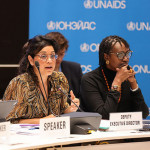Friday, December 1, marks the 35th annual Worlds AIDS Day, a time for people across the globe to remember those lost to the pandemic, honor those fighting HIV and living with the virus and raise awareness of and support efforts to end AIDS.
With so many other things going on in the world, it is important to remember #WorldAidsDay2023 and the aim of ensuring everyone has access to prevention and treatment. pic.twitter.com/vFTivDKSSW
— Dr Philippa Whitford (@Dr_PhilippaW) December 1, 2023
“This year’s theme—‘World AIDS Day 35: Remember and Commit’—pays tribute to those we have lost to HIV/AIDS. The impact of this epidemic has been profound, affecting individuals, families and entire communities across the globe,” according to HIV.gov. “Remembering the lives lost not only honors their memory but also emphasizes the urgency of our commitment to end the HIV epidemic.…
“The other aspect of this year’s theme, ‘Commit,’ emphasizes our collective responsibility to act. Each one of us can make a difference, whether through working to improve health equity and ending the disparities in access to prevention, care and treatment; promoting scientific education and awareness; or supporting organizations that work tirelessly to serve those at risk [for] and living with HIV—we need a whole of society response to win.”
Danza Azteca is a living, evolving cultural tradition using the pre-Colombian Aztecs’ artistic, spiritual practices. It’...
Posted by National AIDS Memorial on Thursday, November 30, 2023
Countless in-person and virtual events take place worldwide to commemorate the annual event. Search #WorldAIDSDay2023 on social media to find ones near you, along with awareness campaigns and messages of support; several examples are embedded throughout this article. You can also peruse a calendar of events and related articles on POZ by clicking #World AIDS Day.
View this post on Instagram
The Joint United Nations Programme on HIV/AIDS (UNAIDS) released a fact sheet on global HIV statistics you can download here. It reads in part:
• 39 million [between 33.1 million and 45.7 million] people globally were living with HIV in 2022. Of these:
– 37.5 million [31.8 million–43.6 million] were adults (15 years or older).
– 1.5 million [1.2 million–2.1 million] were children (0–14 years).
– 53% were women and girls.
– 86% [73–98%] knew their HIV status in 2022.
• 1.3 million [1 million–1.7 million] people became newly infected with HIV in 2022.
• 630,000 [480,000–880,000] people died of AIDS-related illnesses in 2022.
• At the end of December 2022, 29.8 million people (76% [65–89%] of all people living with HIV) were accessing antiretroviral therapy, up from 7.7 million in 2010.
• 9.2 million people living with HIV did not have access to antiretroviral treatment in 2022.
Access to HIV treatment is not only lifesaving. People with HIV who achieve and maintain viral suppression also experience slower disease progression, enjoy better overall health and are less likely to develop opportunistic illnesses. What’s more, people with an undetectable viral load don’t transmit HIV to others through sex (dubbed treatment as prevention, or Undetectable Equals Untransmittable, or U=U).
FT LAUDERDALE, FL: Join CAN Community Health for a special World AIDS Day ceremony alongside the Galleria Fort...
Posted by CAN Community Health on Thursday, November 30, 2023
In the United States, 1.2 million people are estimated to be living with HIV, and about 13% don’t know it, according to data from the Centers for Disease Control and Prevention. Slightly over 31,000 people were diagnosed with HIV in 2021. HIV incidence is disproportionately high in the South and among gay and bisexual men (notably Black and Latino men), a group that accounted for about 70% of new cases in 2021. Transgender women, African Americans, Latinos and injection drug users also experience higher rates of HIV.
Then finally clips from 2018 and at home in 2020. So much has changed since 2012, effective drugs, Prep and U=U (undetectable means untransmittable), but there is still a way to go to ensure treatment is available to everyone equally. #MattBomer #WorldAIDSDay2023 pic.twitter.com/decdHIB4ws
— Matt Bomer United (@MattBomerUnited) December 1, 2023
“World AIDS Day arrives at a defining moment. AIDS-related deaths have fallen by almost 70% since their peak in 2004, and new HIV infections are at the lowest point since the 1980s. But AIDS still takes a life every minute,” said U.N. Secretary General António Guterres in a World AIDS Day statement, which you can watch below.
“We can—and must—end AIDS as a public health threat by 2030. Reaching this goal means heeding this year’s [UNAIDS report’s] theme: ‘Let Communities Lead.’ The path to ending AIDS runs through communities,” he continued. “From connecting people to the treatment, services and support they need to the grassroots activism pushing for action so all people can realize their right to health—supporting those on the front lines of the battle against AIDS is how we win.”
The UNAIDS report, Let Communities Lead, was released on the eve of this year’s World AIDS Day and touts the successes and importance of community-based organizations in the fight against HIV.
To learn more about HIV in the United States, visit AIDSVu.org., which creates interactive maps based on HIV data. On the site, you can:
- See data on HIV and pre-exposure prophylaxis (PrEP) use on AIDSVu’s interactive map.
- Find available HIV testing, prevention and care services near you with AIDSVu’s service locators.
- Read expert-led Q&A blogs to deepen your understanding of the history and impact of the HIV epidemic.
- Share infographics with friends and family to raise awareness.
Check out this awesome event!
Posted by AIDS Foundation Chicago on Monday, November 27, 2023
2nd Annual Timothy Rav Brown Community Cure Symposium Join us as we mark World AIDS Day in partnership with the...
Posted by HIV + Aging Research Project-Palm Springs on Monday, November 27, 2023
Click on the POZ hashtag #World AIDS Day and you’ll find a 2023 calendar of events and headlines such as “World AIDS Day Through the Years” and “First Person Cured of HIV to Be Honored With a Star and Symposium.”







Comments
Comments